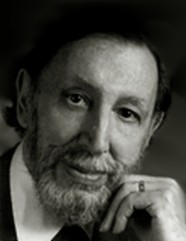Alan Hovhaness (1911-2000)
Born March 8, 1911 in Somerville, Massachusetts.
Died June 21, 2000 in Seattle, Washington.
Mysterious Mountain (Symphony No. 2), Op. 132
Composed in 1955.
First Performance: October 31, 1955 with Leopold Stokowski conducting the Houston Symphony Orchestra.
Instrumentation: 3 flutes, 2 oboes, English horn, 2 clarinets, bass clarinet, 2 bassoons, contrabassoon, 5 horns, 3 trumpets, 3 trombones, tuba, timpani, celesta, harp, strings
American composer Alan Hovhaness studied at the New England Conservatory of Music and later in Finland. His music combines his interests in Gregorian chant, Renaissance polyphony and the musical traditions of his Armenian religious background. The title Mysterious Mountain was not in the composer’s thoughts during the composition, but occurred to him after the work was completed, thereby reflecting the affect the music had on him.
[amazon text=Mysterious Mountain&asin=B000003FMX] is in three movements. The opening Andante con moto begins with hymn-like open voiced chords in the strings. This builds to a climax and is followed by lyrical melodies tossed between the woodwinds over a pizzicato string background, while the celesta intermittently interjects the only “dissonance” in the piece. The strings then recapitulate the hymn while alternating with a solo trumpet in a call and response manner.
The moderato maestoso second movement is a double fugue. The first fugue subject is lyrical and hymn-like, perhaps recalling “Yes, Jesus loves me.” The second subject is very fast with a repeated minor third pattern. Eventually both themes are skillfully combined “with strict four-voice canonic episodes and triple counterpoint episodes.”[1] The movement ends with a cessation of activity and is once again hymn-like.
The Andante espressivo Finale starts with a chant in the horns echoed by the trombones. This is followed by a con moto section that begins softly with the horns carrying the melody in counterpoint over a harp and timpani accompaniment. Repeated patterns begin appearing in the strings, while the horns are joined by the woodwinds, and finally the trumpets, to reach the climax of the movement. The open voice string hymn texture from the opening of the first movement returns, followed by a molto cantabile section featuring woodwind solos, with the celesta once again injecting an “off-key” arpeggio. The movement ends with an evocation of the opening chant one final time.
[1] Alan Hovhaness
Resources
[amazon template=iframe image&asin=B000003FMX][amazon template=iframe image&asin=B00CH7X2TA][amazon template=iframe image&asin=B000000FMX][amazon template=iframe image&asin=B0000006ZD]
[amazon template=iframe image&asin=0793510236][amazon template=iframe image&asin=B00HV4FO2C][amazon template=iframe image&asin=B009AWT9XS]
